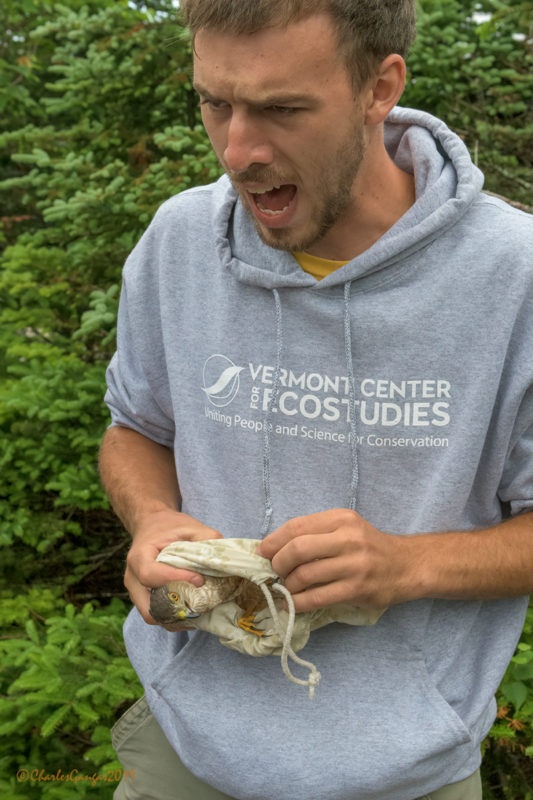
Who ever said bird banding is pain-free? Spencer Hardy gets ‘taloned’ extricating a Sharp-shinned Hawk from a bird bag. Mt. Mansfield, 19 July 2019. © Charles Gangas
Hard as it may be to believe, the avian breeding (and Mt. Mansfield banding) season is winding down. VCE’s seventh session of 2019 on our long-term ridgeline study plot met with ideal evening weather on 18 July—calm, warm, mixed cloud cover. A spectacular sunset far eclipsed the muted dusk avian chorus, but we managed to capture 14 birds by the time we furled nets at dusk, including the season’s first stub-tailed Bicknell’s Thrush and Blackpoll Warbler fledglings. In fact, a presumed Blackpoll family captured simultaneously provided a rare photo op (below).
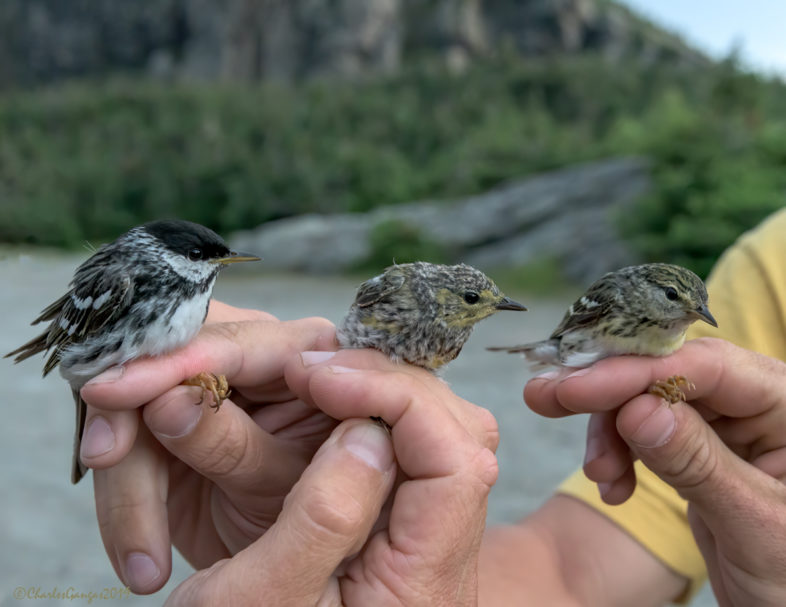
All in the family: a multi-generational trio of Blackpoll Warblers captured together on Mt. Mansfield, 18 July 2019. From left: adult male, recently-fledged juvenile, adult female. © Charles Gangas
To our surprise, clouds lowered overnight and a west breeze kicked up, making for a chilly and somewhat wet morning. After a very slow start and some gradual, if weak, solar warming, activity picked up. We ended the morning with 34 captures, including fledged juveniles of several species. Highlights among our total of 48 mist-netted individuals were a feisty female Sharp-shinned Hawk (whose rapier talons twice found purchase in Spencer’s flesh), two Blue-headed Vireos (our first captures since 2017), and a classy Black-throated Green Warbler. One juvenile Catharus thrush had us briefly stumped as to its specific identity—with an eye ring more buffy than we thought typical of Bicknell’s (leading us to think Swainson’s)—but its slightly emarginated primary #6 proved the clincher (see below).
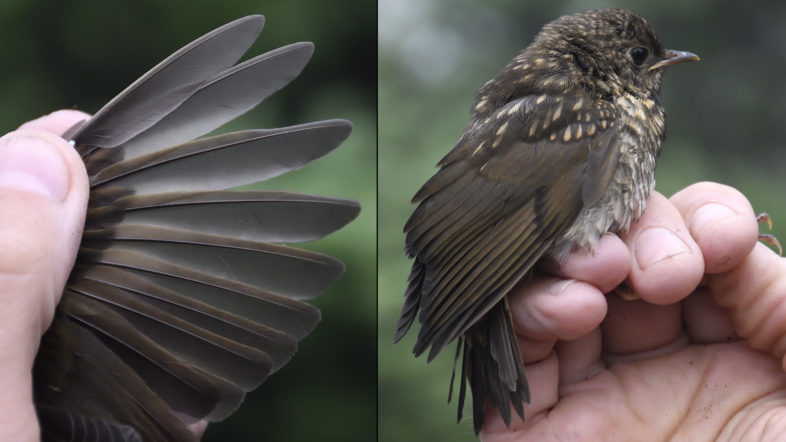
Juvenile Bicknell’s Thrush (right) with spread wing (left) showing slight emargination on outer edge of primary #6 (4th from top), a reliable way to separate this species in juvenal plumage from Swainson’s Thrush. © Michael Sargent
Our final Week 7 tally:
Sharp-shinned Hawk — 1 adult female
Blue-headed Vireo — 2 adults captured together; female with regressing brood patch and in early primary molt
Winter Wren — 1 within-season recapture male
Ruby-crowned Kinglet — 1 within-season recapture female with regressing brood patch
Bicknell’s Thrush — 10, including 3 stub-tailed juveniles, 2 return males (banded in 2011 and 2013), 5 within-season recaptures
Hermit Thrush — 1 yearling female with regressing brood patch\
American Robin — 1 free-flying juvenile (first of season)
Dark-eyed Junco (Slate-colored) — 13, including 10 free-flying juveniles, 3 within-season adult recaptures
White-throated Sparrow — 2 new adult males
Blackpoll Warbler — 12, including 4 stub-tailed juveniles, 3 new females, 1 new male, 2 female returns from 2018, 2 within-season recaptures
Yellow-rumped Warbler (Myrtle) — 3 new adult females
Black-throated Green Warbler — 1 new adult male
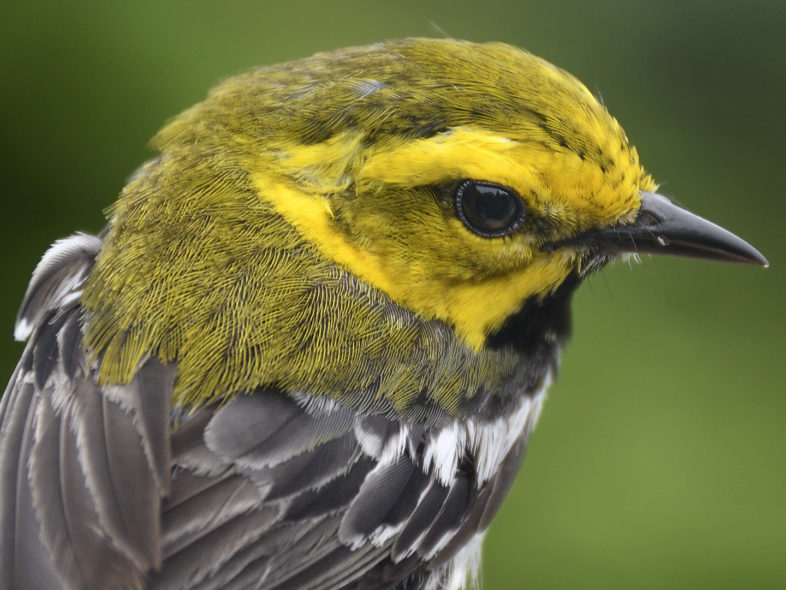
A male Black-throated Green Warbler, not a montane forest species per se, but an annual post-breeding wanderer to the Mansfield ridgeline. © Michael Sargent
Inevitably at this time of summer, we capture birds banded in previous years that we have not yet netted this season. Two male Bicknell’s Thrushes were especially notable in this regard: #2341-24085, banded as a yearling on 3 June 2011 and recaptured every single year since, is among our oldest-ever birds at age 9—talk about strong site fidelity and survivorship! The second is #1931-76718, who we banded as a 2+ year-old on 13 July 2013 (meaning it was hatched in at least 2011), missed in 2014, recaptured again (but just once) in both 2015 and 2016, then missed in 2017 and 2018. It is now a minimum of 8 years old, but has appeared in our nets in only 4 of those 8 years. Its main annual home range is likely just outside our netting area. We also recaptured two 2018-banded adult female Blackpoll Warblers for the first time this summer. As the breeding season winds down and local families or failed adults begin to disperse, it’s not surprising that we capture individuals who might not have strayed into our nets earlier in the season.
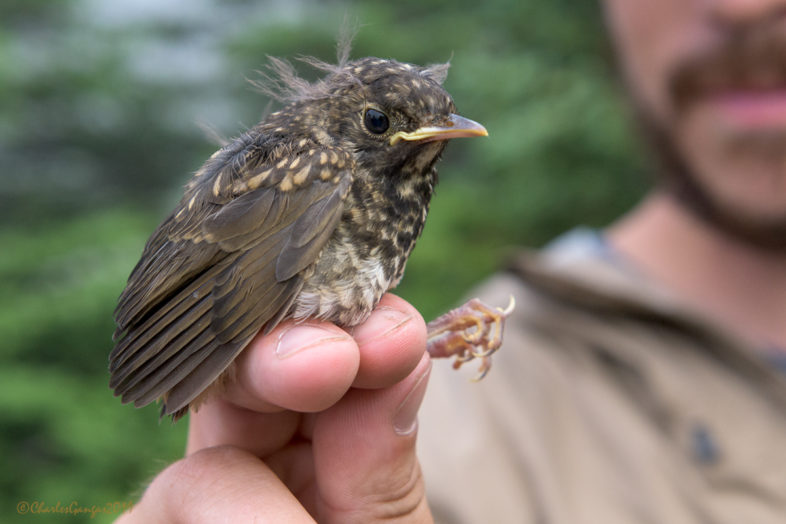
Definitely NOT a face only a mother could love: a barely-out-of-the-nest fledgling Bicknell’s Thrush, Mt. Mansfield, 19 July 2019. © Charles Gangas
With only two visits to go in 2019, we’re still well behind numbers of a year ago, but we’ll hold out hope for a solid season-ending surge, and some surprises. Stay tuned.
←
